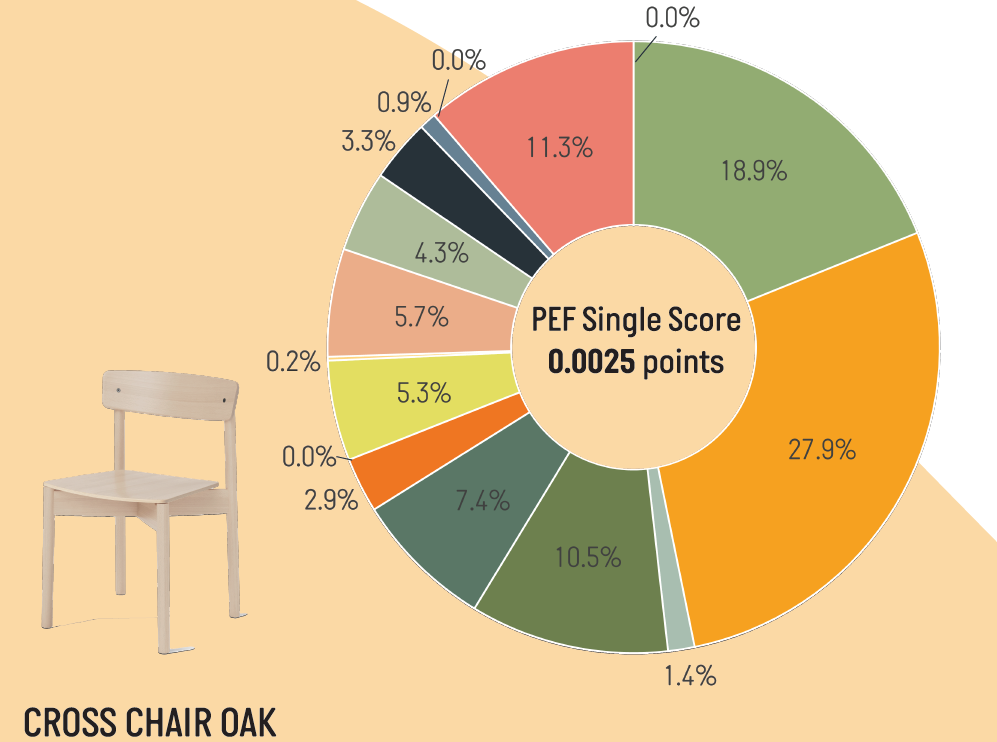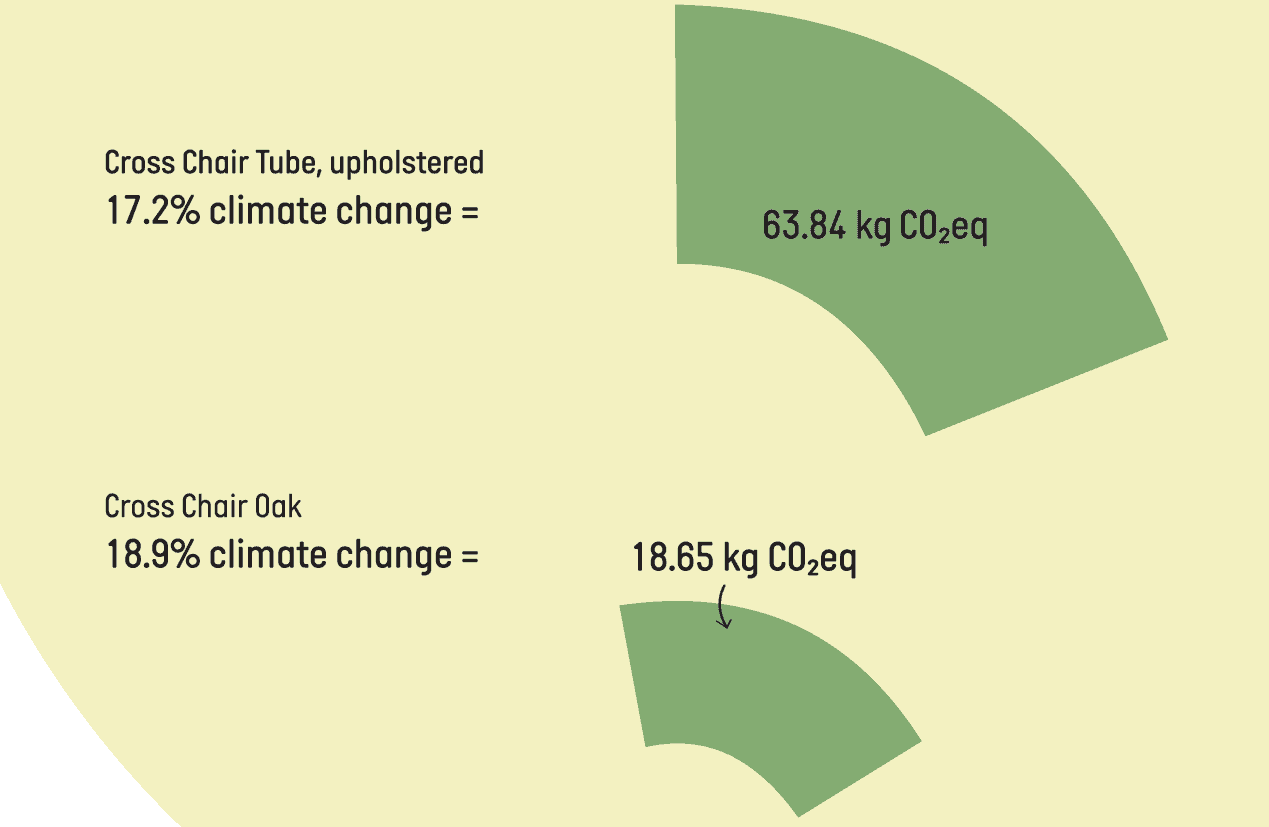Målbar calculations receive independent seal of approval
Målbar has made PEF compliant calculations on the total environmental impact of TAKT’s Cross Chair Collection and our calculations have been approved and verified by third party, Bureau Veritas. This time, we have gone beyond measuring climate footprint. Through 16 impact categories defined by PEF, we have measured the total environmental performance of the Cross Chair Oak and the Cross Chair Tube, upholstered.
Seal of approval
Having our calculations verified by a third party means that our calculation methods and data foundation have achieved an important seal of approval and recognition.
Furthermore, it ensures that we are on the right track. It reaffirms our ability to continuously provide transparent and trustworthy data to our existing and future customers so that they have a real chance of knowing where they should aim to make the most effective environmental improvements. It is paramount to be able to see where you can make a positive difference as a company to avoid initiating random reduction plans. Reliable data must be the foundation for any sustainability strategy.
The verification from Bureau Veritas proves that we can do that.
“As pioneers in PEF LCA within the furniture industry, securing third party verification from Bureau Veritas has been pivotal. Their validation reaffirms the accuracy of our models in compliance with EU regulations, cementing our commitment to transparency and credibility within footprint calculations.” – Anders Koefoed, Co-founder & Head of Data at Målbar
Moving from climate change to total environmental performance
When manufacturing any product, it affects more than our climate. The production of goods also influences other essential environmental areas such as water use, resource use, air pollution, soil fertility, human health, etc. Climate change is by far the most urgent and impactful category seen from a global perspective, but we need to consider the other parameters too.
Following the PEF LCA method, measuring the impact on all 16 environmental categories allows for summing up to a single score that reflects the overall environmental performance of a product. This assessment marks a significant departure from traditional environmental reporting methodologies.
“Now, we have moved forward to an approach which ensures that every facet of the 16 impact categories is measured and addressed, and very importantly, they are proportionally handled by their accumulated impacts. This evolution reaffirms our dedication to present solutions to the industry so we can push the green transition further.” – Jakob Aaen, CEO of Målbar
For the first time, the total environmental impact of Danish furniture has been measured – by Målbar, and verified
– by Bureau Veritas.

Together with Målbar, we are pioneering the use of PEF reporting. We believe that the bigger picture of environmental impact it provides is a fairer, more transparent way of sharing information. PEF analysis is rigorous in its scope and process, and just because carbon is low doesn’t mean impact is low. I’ve been thrilled with our collaboration with Målbar. They expertly calculated emissions across all 16 environmental categories and their ambitious and skilled engineers ensured a smooth process, even challenging us to secure the best outcomes. Their commitment to excellence in the green transition is unmatched.” – Henrik Taudorf Lorensen, founder of TAKT.
Main results
So how does a full life cycle assessment on 16 environmental impact categories look like?
Here are illustrated the total environmental performance of the Cross Chair Tube with the highest total impact, and of the Cross Chair Oak with the lowest total impact. The total impacts are reflected by the PEF Single Score numbers in the middle of the pie charts, whereas each color represents the impact part of each impact category.
Take outs:
- The results of the two chairs show large differences within the various impact categories as well as in the PEF single score.
- The leather seat cover represents the dominating impact for the upholstered chair. For climate change, leather alone constitutes 60%.
- Leather is the main reason why the chair has more than 4 times higher single score than the Cross Chair Oak.
- For the PEF single score of both chair variants, the most contributing impact categories are climate change and particulate matter.
Målbar is able to present these detailed data to the public because our calculations have been third party verified.
TAKT Cross Chair Oak


TAKT Cross Chair Tube, upholstered


Diving into the impact categories
Below, you can see the Cross Chairs’ impact on three selected impact categories. We have picked these out to exemplify some of the most significant impacts that the Cross Chairs have on the environment.
Unfold to view the components and processes of the Cross Chair Oak and the Cross Chair Tube that contribute to:

Leather: Cattle farming contributes to climate change mainly through methane emissions. The tanning process relies on high water consumption and the use of chemicals such as chromium and heavy metals, which can contaminate water, soil, and air.
Metal tube frame: Steel production relies on the use of furnaces to melt the raw metals, which are usually powered by fossil fuels.
Landfilling of wood: At the end of their lives, wood products disposed of in landfills end up decomposing and releasing carbon dioxide and methane.
Furniture production: The production of wood furniture involves heating and drying processes. These can be obtained by burning fossil fuels, which contribute to climate change.

Leather: The tanning process relies on high water consumption and the use of chemicals such as chromium and heavy metals, which can contaminate water, soil, and air.
Metal tube frame: Steel production relies on the use of furnaces to melt the raw metals, which are usually powered by fossil fuels. The crushing, grinding, and handling of raw materials such as iron ore can generate dust particles.
Furniture production: The production of wood furniture involves heating and drying processes. These can be obtained by burning wood waste which can release particles into the air.

Leather: The tanning process relies on high water consumption and the use of chemicals such as chromium and heavy metals, which can contaminate water, soil, and air.
Metal tube frame: The steelmaking process releases sulphur dioxide (SO2) and nitrogen oxides (NOx), which contribute to the acidification of soil and water.
Furniture production: The production of wood furniture involves heating and drying processes. These can be obtained by burning fossil fuels, which contribute to climate change and acidification.
Comparing the environmental impacts
Below, we illustrate the difference in impacts from the two Cross Chairs on the three selected impact categories. We show the result in the specific units that are used to measure the respective impact categories
Unfold to view the proportional impacts on:
TAKT Cross Chair Collection report, summary
16 Environmental Impact Categories
Looking forward
At Målbar, we have learned a lot through this comprehensive process, and we have gained so many useful insights.
It’s also important to acknowledge the challenges that come with being the first to navigate this terrain.
Traditionally, LCA work entails a comprehensive analysis of a product’s life cycle, requiring access to extensive research and data. From an engineering standpoint, this poses a challenge, especially when there are no prior reports or established frameworks to lean on.
This is one of the reasons why we have spent large amounts of time developing reliable methods for data collection and analysis which can comprise all 16 impact categories.
Having Bureau Veritas, one of the world’s largest and most reliable certification bodies, verify our work is paramount to our future work. And we are happy to be incorporating this knowledge into an enhanced version of our screening tool and hereby allow our customers to calculate PEF results themselves.



